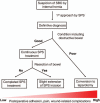Single-port surgery (SPS) strategy for small bowel obstruction (SBO) caused by postoperative internal hernia: A series case report
- PMID: 29595689
- PMCID: PMC5895389
- DOI: 10.1097/MD.0000000000010269
Single-port surgery (SPS) strategy for small bowel obstruction (SBO) caused by postoperative internal hernia: A series case report
Abstract
Rationale: Internal hernia due to postoperative adhesions sometimes causes small bowel obstruction (SBO) and requires emergency surgery. The difficulties in the management of SBO with internal hernia include accurate diagnosis and estimation of its ischemic degree and of the risk of SBO recurrences following the surgical procedure. Laparoscopic surgery is a noninvasive to reduce postoperative adhesions and therefore has been widely used recently. However, surgeons often tend to hesitate in applying laparoscopic surgery for SBO because of some situational disadvantages such as poor operating space or iatrogenic bowel injury. Hence, laparoscopic surgery is still not yet the standard procedure for SBO caused by internal hernia. Thus, the establishment of an appropriate procedure for SBO due to internal hernia is required.
Patient concerns: We experienced 3 SBO cases caused by postoperative internal hernia. The first patient was a 59-year-old man who had temporary loop-ileostomy for a perforated sigmoid colon due to diverticulitis. Severe hypogastralgia and vomiting occurred suddenly on the 33rd postoperative day. The second patient was an 81-year-old man who had been hospitalized due to epigastralgia of unknown origin. He had a surgical history of omentum patching for a perforated duodenum 20 years ago. The third patient was a 72-year-old female who presented at our hospital after sudden and severe hypogastralgia. She had a surgical history of sigmoidectomy for her sigmoid colon cancer 22 years ago.
Diagnosis: A contrast computed tomography (CT) revealed a suspected closed loop obstruction of their bowels and immediate surgical treatments were required.
Intervention: We tried SPS using the surgical glove method as an initial approach for their SBO caused by postoperative internal hernia.
Outcomes: Two of these 3 cases completely underwent SPS treatment, which afforded accurate diagnosis of SBO. Laparotomy following SPS, which allowed accurate diagnosis, was judged to be appropriate and was performed in the third case. All the patients were discharged without any complications and SBO have not recurred after their discharge. Finally, we established a new strategy using SPS for SBO with internal hernia.
Lessons: Our experience suggests that SPS is a promising strategy as an initial surgical approach for SBO with internal hernia.
Conflict of interest statement
The authors have no conflicts of interest to disclose.
Figures





Similar articles
-
Post-operative transmesosigmoid hernia causing small bowel obstruction: a case report.Pan Afr Med J. 2015 Apr 1;20:318. doi: 10.11604/pamj.2015.20.318.5752. eCollection 2015. Pan Afr Med J. 2015. PMID: 26175809 Free PMC article.
-
Risk Factors for Small Bowel Obstruction After Laparoscopic Ileal Pouch-Anal Anastomosis for Inflammatory Bowel Disease: A Multivariate Analysis in Four Expert Centres in Europe.J Crohns Colitis. 2019 Mar 26;13(3):294-301. doi: 10.1093/ecco-jcc/jjy160. J Crohns Colitis. 2019. PMID: 30312385
-
The role of laparoscopy in the management of acute small-bowel obstruction: a review of over 2,000 cases.Surg Endosc. 2012 Jan;26(1):12-7. doi: 10.1007/s00464-011-1885-9. Epub 2011 Sep 5. Surg Endosc. 2012. PMID: 21898013 Review.
-
Laparoscopic paracecal hernia repair.J Laparoendosc Adv Surg Tech A. 2003 Feb;13(1):55-7. doi: 10.1089/109264203321235494. J Laparoendosc Adv Surg Tech A. 2003. PMID: 12676024
-
Laparoscopic management of small bowel obstruction secondary to a mesodiverticular band of a Meckel's diverticulum in an adult: A case report and literature review.Medicine (Baltimore). 2024 Jul 26;103(30):e39164. doi: 10.1097/MD.0000000000039164. Medicine (Baltimore). 2024. PMID: 39058819 Free PMC article. Review.
Cited by
-
Exploring the use of single-port surgery in the conservative management of hepatic portal vein gas: A case report.Medicine (Baltimore). 2018 Nov;97(47):e13368. doi: 10.1097/MD.0000000000013368. Medicine (Baltimore). 2018. PMID: 30461657 Free PMC article.
-
Long-Term Consequences of Nonclosure of Mesenteric Defects after Traditional Right Colectomy.Biomed Res Int. 2018 Sep 26;2018:9123912. doi: 10.1155/2018/9123912. eCollection 2018. Biomed Res Int. 2018. PMID: 30356463 Free PMC article.
References
-
- Choi BJ, Kim SJ, Lee SC, et al. Single-port laparoscopic treatment of small bowel obstruction. Am J Surg 2014;208:470–5. - PubMed
-
- Pfluke JM, Parker M, Stauffer JA, et al. Laparoscopic surgery performed through a single incision: a systematic review of the current literature. J Am Coll Surg 2011;212:113–8. - PubMed
-
- Suzuki Y, Katagiri H, Yoshinaga Y, et al. Internal hernia caused by epiploic appendices successfully treated by single-incision laparoscopic surgery (SILS). Hernia 2015;19:1011–3. - PubMed
-
- Asakuma M, Hayashi M, Komeda K, et al. Impact of single-port cholecystectomy on postoperative pain. Br J Surg 2011;98:991–5. - PubMed
Publication types
MeSH terms
LinkOut - more resources
Full Text Sources
Other Literature Sources
Medical

